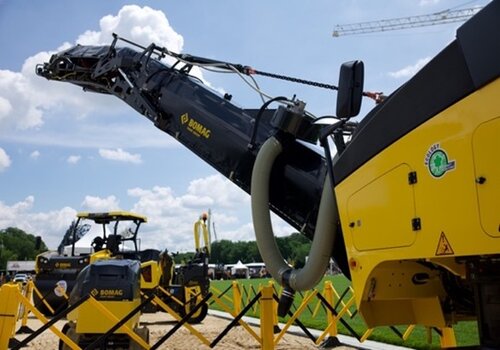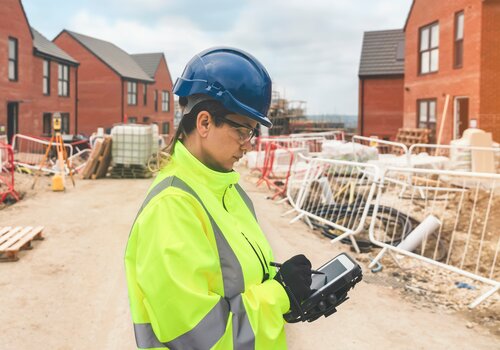In recent years, the construction industry has witnessed a technological transformation, and one of the most significant game-changers has been the integration of drone technology.
Drones, or unmanned aerial vehicles (UAVs), have revolutionized various sectors in recent years, and their impact on construction cannot be understated. These agile, high-flying machines are rapidly becoming indispensable tools for construction companies, offering enhanced efficiency, cost savings, improved safety and unparalleled precision.
Drones are no longer a “nice to have” – they are an accurate and reliable technology well on their way to becoming necessary equipment for construction companies. That's according to Richard Hordern-Gibbings, Director of Partnerships at Propeller Aero, who spoke to CONEXPO-CON/AGG attendees in spring 2023.
“I’m confident that in the next three-to-five years, three-quarters of all construction companies will be using this technology,” he said. “So, it’s a great time to look at what your use is currently and if you could expand it, or if you’re not using it, it’s a great time to learn more.”
The most common drone uses today
- Aerial Surveys and Mapping: Drones equipped with advanced surveying and mapping software can quickly capture high-resolution aerial imagery, topographical data and 3D models of construction sites.
- Progress Monitoring and Inspections: Drones can be programmed to conduct routine flyovers, capturing real-time images and videos of the site. This data can then be compared to initial project models, enabling stakeholders to assess project advancement, identify potential delays and resolve issues promptly. Drones also are adept at conducting safety inspections of hard-to-reach or hazardous areas, reducing the need for workers to expose themselves to risky environments.
- Enhanced Safety Measures: Drones have made remarkable strides in minimizing risks and accidents. They are equipped with high-definition cameras, thermal sensors and LiDAR technology, which can detect potential hazards like structural weaknesses, electrical issues and gas leaks.
- Material Delivery and Inventory Management: Drones are not only limited to capturing data but can also be utilized to transport lightweight construction materials across job sites efficiently. Additionally, drones can assist in inventory management by conducting automated stockpile measurements, ensuring that the right number of materials is available when needed, preventing unnecessary and costly delays.
- Building Information Modeling (BIM) Integration: By incorporating aerial data into BIM software, construction teams can create comprehensive digital representations of projects. This synergy helps in better visualization, coordination and collaboration among stakeholders throughout the project lifecycle.
But what really is the ROI?
While initial investments in drone technology may seem significant, the long-term benefits outweigh the costs – and in many instances even lead to companies seeing savings in time and money. Reducing errors and rework, decreasing production time when data is available faster for real-time decision-making, and the enhanced ability to win bids by proving your ability to embrace innovation are all factors that make drone use an easy decision for any company.
Propeller estimates from research with its clients that the use of drones on the jobsite equates to an estimated 20% improvement in efficiency.
While drones won’t solve every problem experienced on a jobsite, their increasing accuracy, affordability and ease of use offers real benefits. In the next coming years, the adoption rate for drones in the construction industry will continue to accelerate, Hordern-Gibbings predicts, so those who do not embrace it may be left behind. Beyond 2023, he said we’ll also continue to see downward pressure on the cost investment required and an expansion of choice for the technology.
Must-know regulation and training
As with any emerging technology, the adoption of drones in construction has faced regulatory challenges. Concerns regarding airspace regulations, pilot licensing and privacy issues have been raised. However, authorities have been proactive in addressing these concerns.
The Federal Aviation Administration (FAA) implemented Part 107, which allows for the safe and legal operation of drones in construction and other industries. Today, more than 300,000 Part 107 certificates have been issued, and there are 314,000 drones registered for commercial use with FAA (although that number is rapidly increasing).
Coming soon: By September 16, 2023, all drone pilots who are required to register their UAS must be compliant with Remote ID, which allows a drone to provide its identification and location through a broadcast signal.
Commercial drone technology in the United States is vetted by the Department of Defense via the Blue UAS, which provides a cleared list of drones that, among other things, are validated as cyber-secure and safe to fly. While the drones on this list are good ones, they’re prioritized for security and safety needs and not necessarily the best for construction industry needs like precision surveying and mapping, said Hordern-Gibbings, who recommends evaluating drones through a hierarchy of needs:
- Accuracy – Trust is a must.
- Reliability – Reliance requires reliability.
- Ease of Use – With experienced pilots, this is less of a need, but depends on your specialization.
- Price – Important to a point, but secondary to accuracy.
In summary
The integration of drone technology in construction marks a significant turning point in the industry's evolution. Drones offer unparalleled advantages in terms of efficiency, safety, precision and cost-effectiveness. As technology continues to advance, drones will undoubtedly play an increasingly vital role in the construction sector.
Construction companies that embrace these cutting-edge solutions will be at the forefront of innovation, enjoying a competitive edge and streamlined processes. The future of construction is literally up in the air and drones are leading the way to new heights of success.
Photo credit: Storyblocks












